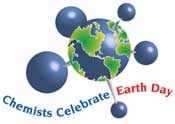Atmosphere: Print Resources
This is a collection of Print Resources about the atmosphere. A separate collection of Electronic Resources is also available.
Most titles below are outstanding and recommended by the National Science Teachers Association that fit this year’s theme for Chemists Celebrate Earth Day. Descriptions are based on reviews from the NSTA or publishers web site.
Key: E = Elementary (K–5), I = Intermediate (6–8), HS = High School (9–12), C = College, G = General Public
- Characteristics of the Atmosphere
- Heating of the Atmosphere
- Atmospheric Pressure and Winds
- The Air We Breathe
Characteristics of the Atmosphere
- Dr. Art’s Guide to Planet Earth: for Earthlings Ages 12 to 120. Art Sussman. White River Junction, VT: Chelsea Green, 2000. 128pp. ISBN 1-890132-73-X. (I, HS)
- Dr. Art’s systems-based Earth guide introduces three
easy-to-understand principles that explain how our planet works —
Matter Cycles, Energy Flows, and Life Webs. This full-color, engaging
guide will help us better understand Earth’s systems. Dr. Jane
Goodall proclaims “[this book] deserves a place not only in
every classroom but also every home.” Includes glossary, index,
and a list of web sites.
Source: NSTA Outstanding Science Trade Books for Children in 2001 - Planet Earth. Robin Kerrod. Minneapolis, MN: Lerner, 2000. 32pp. ISBN 0-8225-3902-0. (E, I)
- Written by Robin Kerrod, a prolific author, astronomer, and Fellow of
England’s Royal Astronomical Society, this book provides a level of
content that is unique for the elementary level. Ten chapters of
accurate text are enhanced with a glossary, an index, and
surface-feature photos. The book’s strongest feature is its
easy-to-read layout. Broad concepts and clear connections to the
unique physical features and processes that occur on the planet are
described. The text is free of gender, class, cultural, and racial
bias. It is easy to read, and incorporates language and explanations
with analogies appropriate for intermediate-age students. The chapter
on continental drift and weather and climate would be appropriate as
an overview or introduction for a unit of either topic.
Source: NSTA recommends - Hands-On Science Series: Atmosphere & Weather. Karen Kwitter and Steven Souza. Portland, ME: J. Weston Walch, 1998. 90pp. ISBN 0-8251-3764-0. (I, HS)
- This book of activities features a carefully structured set of 16 to
20 activities requiring one or two class periods, with unusually
complete teacher support. It provides very useful enrichment for a
middle school Earth science curriculum in the form of in-class and
out-of-class activities and group projects. Each is supported by
suggestions for pre-class preparation, instructional objectives,
National Science Education Standards, required materials, helpful
hints, and adaptations for both high and low achievers. Evaluation
plans include quizzes with answers.
Source: NSTA recommends
Heating of the Atmosphere
- Global Warming: A Threat to our Future. Paul Stein. NY: Rosen, 2001. 64pp. ISBN 0-8239-3414-4. (I)
- One of eight volumes in The Library of Future Weather and Climate
series, this is an excellent reference on an important topic. The
author does not question the reality of global warming, but argues
for more research on temperature increases since 1979. The first
chapter explains that the temperature of the Earth depends upon the
balance between incoming solar radiation and Earth’s outgoing
radiation. The book gives a precise definition of photosynthesis and
a clear explanation of the relationship between that process and
carbon dioxide in the atmosphere. After outlining the link between
the burning of fossil fuels and the greenhouse effect, the author
concludes with a call for further study of climate and its impact on
our planet.
Source: NSTA recommends
The Air We Breathe
- The Story of Oxygen. Karen Fitzgerald. Danbury, CT: Franklin Watts/Grolier, 1996. 64pp. ISBN 0-531-20225-9. (E, I)
- From myth and mystery to discovery and explanation, the author
chronicles the experimentation with air and ultimately, oxygen. The
book describes the unique characteristics of oxygen, such as its
importance to life, chemical behaviors, and abundance. Many
scientists and their contributions are covered. Includes a
bibliography, glossary, and index.
Source: NSTA Outstanding Science Trade Books for Children in 1997
Copyright © 2005 American Chemical Society

